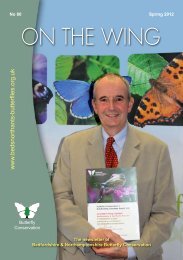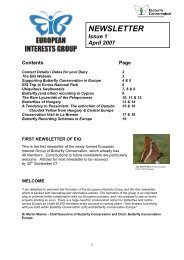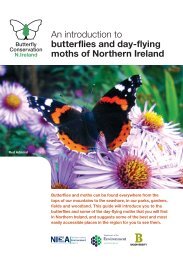The Comma • Autumn 2011 - Butterfly Conservation
The Comma • Autumn 2011 - Butterfly Conservation
The Comma • Autumn 2011 - Butterfly Conservation
You also want an ePaper? Increase the reach of your titles
YUMPU automatically turns print PDFs into web optimized ePapers that Google loves.
<strong>The</strong> third day began locally at a<br />
dry, stony, parched valley floor with<br />
no sign of life for a considerable<br />
time. <strong>The</strong>n an Eastern Rock<br />
Grayling was netted with no<br />
intention of hanging around upon<br />
release and a bright Levantine<br />
Skipper was next to put in an<br />
appearance. A mint-condition<br />
Lattice Brown came into view<br />
intent on resting low down in<br />
bushes and on trees and a couple of<br />
Mersin’s (Samos) Graylings were<br />
seen plus a sole Small Bath White and Sloe<br />
Hairstreak.<br />
<strong>The</strong> ancient ruins of Olympos were approached<br />
along a hot beach where a solitary Mediterranean<br />
Skipper nectared on a lantana bush. No sooner had<br />
we reached the beach than we found Lulworth<br />
Skippers around a low bush and Ilex Hairstreaks<br />
were also present. <strong>The</strong> river that flows into the sea at<br />
this point leads upstream to the Lycian, and earlier,<br />
ruins of old Olympos. <strong>The</strong> group became fixated on<br />
something on a low wall: it turned out to be a fresh<br />
Southern Swallowtail in beautiful condition. Our<br />
one and only Green-veined White put in an<br />
appearance here also. <strong>The</strong> long journey west to our<br />
second base at Kas then began.<br />
<strong>The</strong> ancient Lycian site theme continued the next<br />
day with a visit to Patara. One or two people saw<br />
snakes and an Eastern Festoon larva was located<br />
under a leaf by Safi. A new butterfly for the trip was<br />
Small Skipper and an obliging Eastern Bath White<br />
permitted us to differentiate it from the Dappled<br />
White. A dark form of the Small Copper was a real<br />
delight and a newly emerged Large Wall Brown was<br />
also seen.<br />
Later on that afternoon, Nigel somehow managed<br />
not only to spot, but also to track in flight, a Grass<br />
Jewel that was buzzing around an<br />
area of stony ground. As thunder<br />
rumbled and more clouds built we<br />
called it a day. Back at our hotel<br />
the weather had now turned ‘big<br />
time’ and the large island offshore<br />
disappeared beneath the storm<br />
heading our way. When it hit us<br />
with tropical intensity the drains<br />
couldn’t cope and before long an<br />
inch of water covered the<br />
restaurant floor.<br />
Egemen had organised a boat<br />
trip to the hamlet of Aperlai and<br />
Lattice Brown<br />
Dark form of Small Copper<br />
after waiting for the rain to stop we<br />
set-off. Brown Argus was<br />
particularly attractive, one of which<br />
had unusual white spots below the<br />
hind-wing orange lunules. <strong>The</strong> walk<br />
back to the boat was capped by an<br />
unidentified Hairstreak that fooled<br />
us all by pretending to be compliant<br />
but which then shot off in the wind<br />
and was lost.<br />
Our penultimate day was spent<br />
in the hills behind Kas, stopping<br />
where the Lycian Way crossed the<br />
road delivering only one each of Eastern Meadow<br />
Brown, Small Copper, Large White, Painted Lady<br />
(plus larvae on thistles), Lattice Brown and two<br />
Clouded Yellows.<br />
On the way in to Kalkan, driven there by rain and<br />
the imaginary smell of coffee, we’d passed through<br />
some lovely habitat and returned there in sporadic<br />
light rain. In wet vegetation we turned-up Common<br />
and Green-underside Blues, a jazzy caterpillar,<br />
whilst Tony located a Cream-spot Tiger, or similar.<br />
With a mid-afternoon flight back home on our<br />
final day there was little further time in the field but<br />
at the Karaman Beli pass some 10km before<br />
Korkuteli at 1,290 metres we dismounted to check<br />
out a lovely herby thyme covered hillside. But boy,<br />
was it cold, despite the sunny intervals! Safi spotted<br />
a Bavius Blue rooster and it was good to see<br />
Chapman’s Blue and Brown Argus in the<br />
windswept conditions.<br />
<strong>The</strong> Lycian site of Termessos became our final<br />
stop. <strong>The</strong> zig-zag approach road was ascended under<br />
a grey sky and cool breeze but a pair of roosting<br />
Eastern Festoons and a solitary Bavius Blue were<br />
found adjacent to the car park. Most of the group<br />
went to see the amphitheatre. A final stop was made<br />
not far from the site entrance where Tony found a<br />
freshly emerged Balkan Marbled<br />
White low down on a yellow sage.<br />
This was to be the last butterfly of<br />
the trip.<br />
A total of 50 butterfly species<br />
had been seen and 71 birds had<br />
been recorded including<br />
(warblers) Olivaceous, Rüppell’s;<br />
(buntings) Cirl, Cretzschmar’s,<br />
Black-headed, and Corn;<br />
(wheatears) Northern, Isabelline,<br />
and Black-eared; (woodpeckers)<br />
Middle-spotted, Lesser-spotted,<br />
and Syrian.<br />
<strong>Autumn</strong> <strong>2011</strong> <strong>•</strong> <strong>The</strong> <strong>Comma</strong> 31







